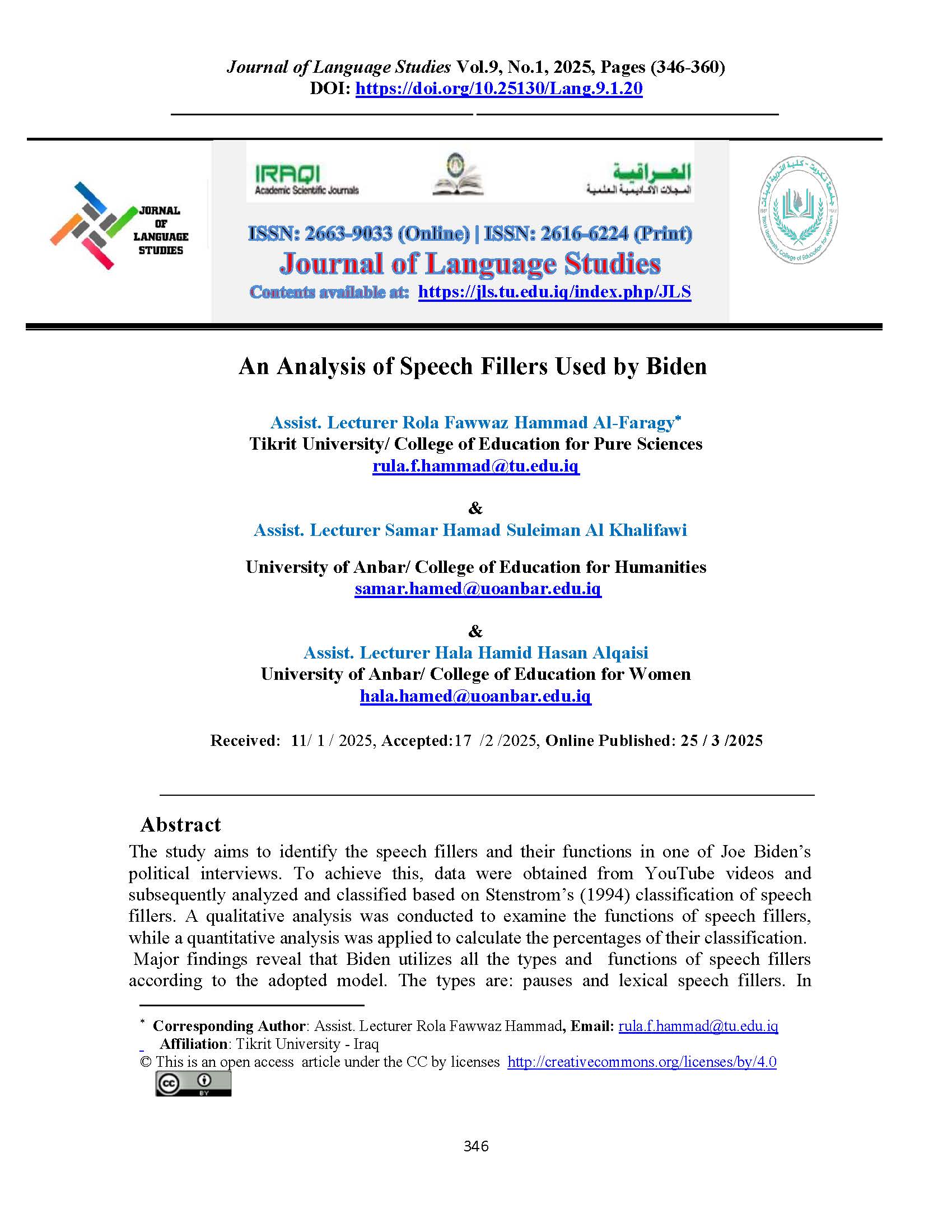An Analysis of Speech Fillers Used by Biden
DOI:
https://doi.org/10.25130/Lang.9.1.20Keywords:
hesitation mark, political interviews, speech fillersAbstract
The study aims to identify the speech fillers and their functions in one of Joe Biden’s political interviews. To achieve this, data were obtained from YouTube videos and subsequently analyzed and classified based on Stenstrom’s (1994) classification of speech fillers. A qualitative analysis was conducted to examine the functions of speech fillers, while a quantitative analysis was applied to calculate the percentages of their classification.
Major findings reveal that Biden utilizes all the types and functions of speech fillers according to the adopted model. The types are: pauses and lexical speech fillers. In addition, the functions are breathing, hesitation mark, filling pause, starter, empathizing, shift marker, editing term, mitigating, holding the turn, time creating device, and sequencer. Biden uses them at different rates. Therefore, in accordance with the findings, the researchers conclude that speech fillers are not usually viewed as a distractions of speaking. As learners of foreign language, we should understand that filler words are not necessarily seen as a distort in speech but also as a way to enhance our interaction and as part of the natural flow of discourse.
References
Abdulla, D. F., & Mohammed, F. O. (2023). Investigating the Use of Fillers by Kurdish EFL University Students in Relation to Speaking Fluency. Humanities Journal of University of Zakho,11(3):724-734
AL-Faragy, R. F. H., & Mohammed, F. J. (2022). Gender and Native-ness Differences in the Use of Speech Fillers in Political Interviews. AL-ADAB JOURNAL, 2(140).
Al-Ghazali A & Alrefaee. (2019). Silent Pauses in the Speech of Yemeni EFL Learners. ELS Journal on Interdisciplinary Studies in Humanities, 2 (1), 39.
Amaglobeli, G. (2017). Types of Political Discourses and Their Classification. Journal of Education in Black Sea Region Vol. 3, No 1. Pages 18-24
Baalen, I. V. (2001). Male and female language: Growing together? Retrieved from http://www.let.leidenuniv.nl/hsl_shl/van%20Baalen.htm.
Brown, G. & Yule, G. (1983). Discourse analysis. Cambridge: Cambridge University Press.
Clark, H. H., & Fox Tree, J.E. (2002). Using uh and um in spontaneous speaking. Cognition, 84: 73-111.
Corley, M. & Stewart, O. W. (2008). Hesitation disfluencies in spontaneous speech: The meaning of um. Language and Linguistics Compass, 2(4):589–602.
Duvall, E, Robbins, A., Graham, T., & Divett, S. (2014). Exploring Fillers Words and Their Impact. SCHWA – Language andria Linguistic, 36-50.
Fors, k, L. (2015). Production and perception of pauses in speech. University of Gothenburg.
Foss, J. D. & Hakes, David J.( 1978). Psycholinguistics: An Introduction to the Psychology of Language. New Jersey: Prentice Hall. Inc.
Fraser, B. (1996). Pragmatic Markers. International Pragmatics Association, 6, 167- 190
Garcia-Lopez, Luis, M. Belén Díez-Bedmar, & Jose M. Almansa-Moreno. (2013). From Being a Trainee to Being a Trainer: Helping Peers Improve their Public Speaking Skills. Revista de Psicodidáctica, 18(2), 331-342
Gryc, J. (2014). Fillers in Academic Spoken English. Brno: Masaryk University.
Jonsson, O. (2016). We Need to Talk About erm Linguistic Fillers: Students' use of linguistic fillers in varying situations.
Kaivanpanah, Sh., Yamouty, P., & Karami, H. (2012). Examining the effects of proficiency, gender, and task type on the use of Communication strategies. Portal Linguarum. Pp. 70-9.
Kharismawan, P. Y. (2017). The Types and The Function of Fillers Used in Barack Obama's Speech. International Journal of Humanity Studies, 1(1), 111-119. : https://doi.org/10.24071/ijhs.2017.010112.
Maclay, H. & C. Osgood 1959 Hesitation Phenomena in Spontaneous English Speech. In Word, 15/??: 19-44.
Oomen, Claudy C. E., & Albert Postma. (2001). Effects of Divided Attention on the Production of Filled Pauses and Repetitions. Journal of Speech, Language, and Hearing Research 44.5. 997-1004. Print.
ProPublica (2023, October 1). The Biden Interview: The President Talks About the Supreme Court, Threats to Democracy, and Trump's Vow to Exact Retribution. Retrieved from https://propub.li/3F0kLWi.
Richards, J. & R. Schmidt. (2010). Longman Dictionary of Language Teaching & Applied Linguistics. Essex: Longman.
Rieger, C.L. (2003) Disfluencies and hesitation strategies in oral L2 tests. Proc. Disfluency in Spontaneous Speech (DiSS 2003), 41-44.
Rose, R. L. (1998). The communicative value of filled pauses in spontaneous speech. Birmingham: Birmingham University.
Schiffrin, D. (1987). Discourse markers. Cambridge: Cambridge University Press.
Seals, D. R., & Coppock, M. E. (2022). We, um, have, like, a problem: excessive use of fillers in scientific speech. Advances in physiology education, 46(4), 615–620. https://doi.org/10.1152/advan.00110.2022.
Stenstrom, A. 1994. An introduction to spoken language interaction. London: Longman.
Szczepek Reed, B. (2011). Analyzing Conversation Introduction to Prosody. UK: Palgrave Macmillan.
Van Dijk, D. A. (Ed) (1997). Discourse as Structure and Process. London: SAGE Publication.
Yule, G. (2014). The Study of Language. Cambridge: Cambridge University Press.

